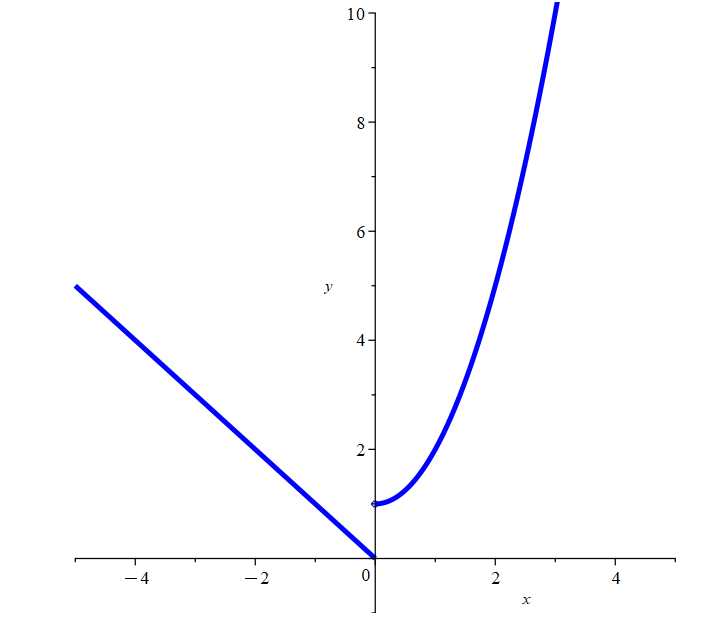Piecewise-Defined Functions
A piecewise function exists when a function is defined by two or more different functions throughout its domain. The first step in evaluating a piecewise function is to determine which function definition applies depending on the value of x that is being input. Once that has been determined, we evaluate the function as usual by substituting in the given value of x.
Example:
Given \(f(x) =
\left\{
\begin{array}{lr}
-x&\text{if}~x<0\\
x^2+1&\text{if}~x\ge0
\end{array}
\right\}\),find \(f(-1)\), \(f(0)\) and \( f(1) \)

Solution: First, we want to evaluate \(f\) at \(x=-1\), so \(f(x)=-x\) is the equation to use
(since it applies whenever \(x<0\)).
\( \displaylines{
f(x) &=& -x \\
f(-1) &=& -(-1) \\
f(-1) &=& 1} \)
Next, we want to evaluate \(f\) at \(x=0\), so \(f(x)=x^2+1\) is the equation to use.
(Since it applies whenever \(x\geq 0\).)
\(\displaylines{f(x) &=& x^2+1 \\ f(0) &=& 0^2+1 \\ f(0) &=& 1} \)
Finally, we evaluate \(f\) at \(x=1\), so \(f(x)=x^2+1\) is the equation to use. (Since it applies whenever \(x\geq 0\).)
\(\displaylines{f(x) &=& x^2+1 \\ f(1) &=& 1^2+1 \\f(1) &=& 2} \)
Absolute Value Functions
An absolute value function can be rewritten as a piecewise function. Absolute value is the distance from a number 'x' to 0 on the real number line. Therefore, when the value of a function is equal to zero or is positive, taking its absolute value doesn't change it; however, if the value is negative, taking absolute value changes the sign. Therefore, the definition of the function changes depending on whether or not x ≥ 0.
\(y = |x| = \begin{cases} x & \text{if } x \geq 0 \\ -x & \text{if } x < 0 \end{cases} \)
Example: Write \(y = |x-2|\) as a piecewise function and evaluate \(f(0)\), \(f(2)\), and \(f(5)\).
Solution:
\( f(x) = \begin{cases} x-2, & \text{if } x \geq 0 ~or~x\geq 2 \\ -(x-2), & \text{if } x < 0~or~x<2 \end{cases} \)
First, to find \(f(0)\), we use \(f(x) = -(x-2)\), since this applies when \(x<2\):
\( \displaylines{f(x) &=& -(x-2) \\ f(0) &=& -(0-2) \\ f(0) &=& 2} \)
Next, to find \(f(2)\), we use \(f(x) = x-2\), since this applies when \(x \geq 2\):
\( \displaylines{f(x) &=& x-2 \\ f(2) &=& 2-2 \\ f(2) &=& 0} \)
Finally, to find \(f(5)\), we use \(f(x) = x-2\), since this again applies when \(x \geq 2\):
\( \displaylines{f(x) &=& x-2 \\ f(5) &=& 5-2 \\ f(5) &=& 3} \)
Example 1:
Example 2:
Example 3:
